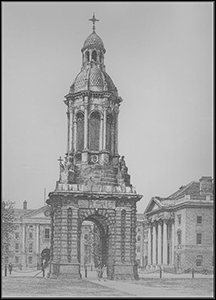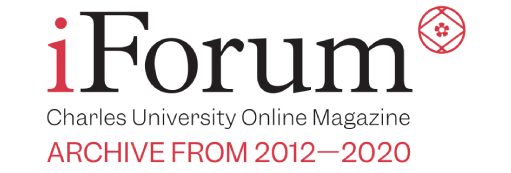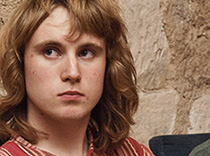William Francis Hannell - International iForum • foto: red. • 10 April 2014
When Celtic and Classical Meet
On the 19th of March a lecture entitled “Classical Learning and the Insular World” was presented by Dr Máire Ní Mhaonaigh of Cambridge University in the library of the Centre for Medieval Studies of Charles University.
The lecture, also billed as “Medieval Ireland and Classical Learning” was part of a series of talks currently underway called “Introduction to Medieval Disciplines and Topics” supported by the University Centre for the Study of Ancient and Medieval Tradition. In it, Dr Ní Mhaonaigh talked about how classical learning and Latin entwined with the Irish vernacular and with Irish tales during the early medieval period, the so-called Dark Ages.

The best known Irish medieval manuscript, the Book of Kells, is on permanent display at Trinity College Library, DublinThese interactions occurred very early on, beginning with Ogam, or Ogham as it is spelt in Modern Irish, in the 4th or 5th centuries. Ogam is Ireland’s earliest alphabet, and consists of a series of ‘lines’ and ‘dashes’, and was often carved on stones; on some inscriptions it is combined with crosses. If we look at how the letters are grouped, we can deduce that whoever framed it was familiar with Latin and 4th century grammatical teaching (Ogam wasn’t restricted to being carved however; scholastic Ogam appeared, that is, Ogam written in manuscripts, alongside the Latin alphabet. The manuscript heritage of Medieval Ireland, as Dr Ní Mhaonaigh emphasised, show that there was great cultural confidence there: for example, in one text written about 799, The Poets’ Primer, Irish is compared directly with Latin, the vernacular being seen as an equal to its classical counterpart.
In this period in Ireland, as Dr Ní Mhaonaigh points out, there was a great Christian Irish culture concerned with a wide range of texts. The Irish authors of this period were undoubtedly highly learned: Sonas Cormaic (Cormac’s Glossary), attributed to a king-bishop of Cashel in the southern part of Munster, Cormac mac Cuilennáin (died 908), suggests that its author had knowledge of Greek, Welsh, and Pictish. Textual production itself was an ecclesiastical activity; court literacy was rare, though texts were developed for courts, the works usually being commissioned by nobles. Such texts were often pseudo-historical or political works, and were written in the vernacular. However, these pre-12th century vernacular works only exist in vernacular manuscripts that survive from the 12th century and later, into which they were copied from earlier manuscripts that have not survived.
Contrary to the conventional image amongst people that the Dark Ages/Early Medieval Ages were some sort of cultural wasteland, populated by barbaric illiterate people, and that the great works of ancient times were forgotten till the Renaissance period, many pieces of classical literature were known in Ireland, and were even adapted, compared and analysed by Irish scholars, a fact that Dr Ní Mhaonaigh stressed through much of the lecture. The Etymologiae of Isidore of Seville was revered in Ireland in this period; to the Irish, it was In Culmen, “The Summit of Knowledge”. So loved was this text that a story relates how the Irish apparently gave away the last copy of their own epic Táin Bó Cúailnge (The Cattle Raid of Cúailnge) to get hold of it.
Knowledge of the Trojan War who then went on to create parallel historiographical narratives of their own history, associating themselves with the Trojans, and thereby giving themselves a parallel foundation for their own creation myth. For example, in a 12th-century manuscript, the Book of Leinster, an adaptation of the Destruction of Troy and The Cattle Raid of Cúailnge appear. In another text in the same manuscript, Cogadh Cáedhel ne Gallaih (The War of the Irish against the Vikings), a hero Murchad is compared to Hector, the work even suggesting that he was descended from a line of heroes that began with Hector himself.
What Dr Ní Mhaonaigh showed in this lecture was that classical learning permeated deeply in the culture of a land at a time which has been often traditionally seen as a time of cultural backwardness. The “insular” in the title only refers to insularity in geographical terms; there’s no negative connotations. With two more lectures to go in the series, hopefully this was just the first in a series of fascinating talks.
|
William Francis Hannell is an Erasmus student from Britain (home university: Aberystwyth University), studying History and English Literature at the Faculty of Arts in Charles University. He joined the IForum as he wishes to gain useful experience as he considers journalism to be a possible future career, and also the opportunity to work with fellow students and to partake in a fun, valuable, and productive experience whilst staying here at Charles University. He also wishes to contribute more than just essays to the university, and be a reliable and informative source for all the various goings-on at the institution. Email is |

